What IS it about Putting?
Research shows that the largest correlation with scores is from driving distance, and that approach shots from the fairway are also important,. While that is true, no one is discussing putting much anymore, almost as if it does not matter!
Most average golfers rarely even bother to practice putting – they probably feel it is a part of their game that they are on par with the pros with.
But the putt is like a golfer’s do-or-die shot! The ‘last hurrah’ on any hole. It can convert a par into a birdie. Or, when made from a guaranteed ‘three putt zone’, convert someone’s likely triple bogey to a far more acceptable bogey.
The three main aspects of a reliable putt are the quality of the stroke itself, as well as distance control (putting speed is said to be the most important aspect of saving putts) and direction judgment.
For any golfer or golf coach wishing to improve their, or their students’, putting stroke, the Capto sensor (an inertial measurement unit or IMU placed on the putter shaft) is head and shoulders above any other device, especially because it measures very many aspects of the putting stroke. Including some extremely unique ones, thanks to the engineering background and mindset of the developer and owner of the company Luca Menci.
The most important outcomes for a good stroke from a speed perspective are the actual speed of the putter at impact (it is said that 3.22 kmph is typical) and the centeredness of contact. For direction, the face, followed by the path matter most.
Also important is energy balance. It is a measure of how much energy is lost as a result of the twisting of the putterface (torque energy loss) resulting in a toe/heel hit. Topspin/backspin and sidespin placed on the ball are also incorporated into the calculation.
Finally, ‘handling’ indicates how much the putterface moves in the hands, and handling is further divided into handling persistence and handling severity. Believe it or not, the Capto sensor even provides information on ‘trembling’ (acceleration in 3D) persistence and severity, an indication of the extent of yips a golfer might have in the putting stroke!
And then there is inventor Menci’s own concept of 3D motion that includes putt (putterhead) kernel, shaft kernel, rotation radius, and three planes – putt plane, shaft plane and sweetspot plane. These concepts are best understood through the excellent Capto certification videos explained in very simple terms by expert putting coach Jochem Burghouts (JB), or by reading Luca Menci’s newly published book ‘Zero in Putting’.
The book has beautiful illustrations, explanations of the more complex concepts by the Maestro himself, and even details about his preferred concepts of address, posture and the putting stroke.
RESEARCH STUDY
INTRODUCTION
So we know how to measure various aspects of a stroke but what actual set-up positions and swing movements can create consistently good results? Variations in both abound.
METHODS
In a course on putting that was taught at Stanton University (Stanton.edu) in June 2023, eight beginner golfers were given an explanation of four putting styles and a mini research study was conducted to see which one worked best.
Each golfer made ten shots (all counted) with one swing style (randomized) and only one style was measured each week (to provide a ‘washout period’ and reduce the likelihood of a ‘carryover effect’ from some movements being copied from another style). They all used the same Mizuno Bettinardi C06 blade putter throughout, and all practiced the strokes for one class each, before the study began.
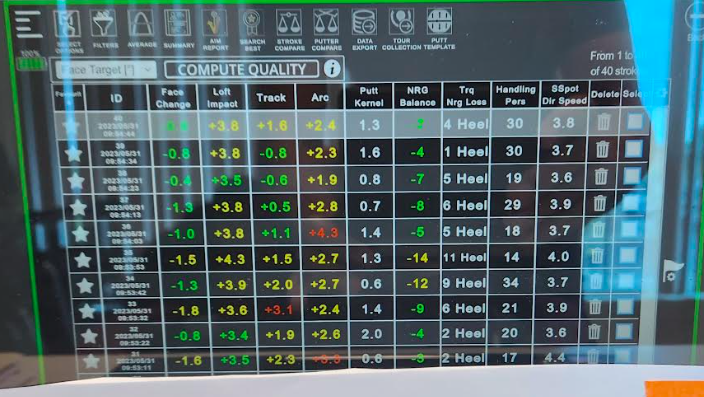
The four putting styles were:
- The Anatomy Based Stroke (TABS) which is based on arms-only movement, rather than involving the torso, which is an anatomically difficult body part to move easily and during the short timeframe of a putt. The stroke was developed by Kiran Kanwar, Ph.D. Kinesiology, as part of the Minimalist Golf Swing System. Basic, but not all, steps for this stroke may be seen in the free eBook on the website YourGolfGuru.com (2010)
- The Putt Doctor’s Stroke (PUDS), which is taken from the relevant chapters of his book ‘The Putting prescription: The putt doctor’s proven prescription for a better stroke’ by Craig Farnsworth (2009). It is mainly a rotate-the-torso for an in-to-out-to-in-stroke.
- The Straight (shoulder) Stroke (SSS) taken from the relevant chapters of his book ‘Optimal putting: Brain science, instincts, and the four skills of putting’ by Geoff Magnum (2008). It is mainly a stroke that requires the putter to swing more straight-back-straight-through
- The Pure In Line Stroke (PILS) taken from the relevant chapters of his book ‘Dave Pelz’ putting Bible: the complete guide to mastering the green’ by Dave Pelz (2000). It is mainly a rock-the-shoulders type stroke that also requires the putter to swing more straight-back-straight-through.
[Note: The names and acronyms for each stroke were created for the students in this class and are not necessarily those given by the developers of the strokes.]
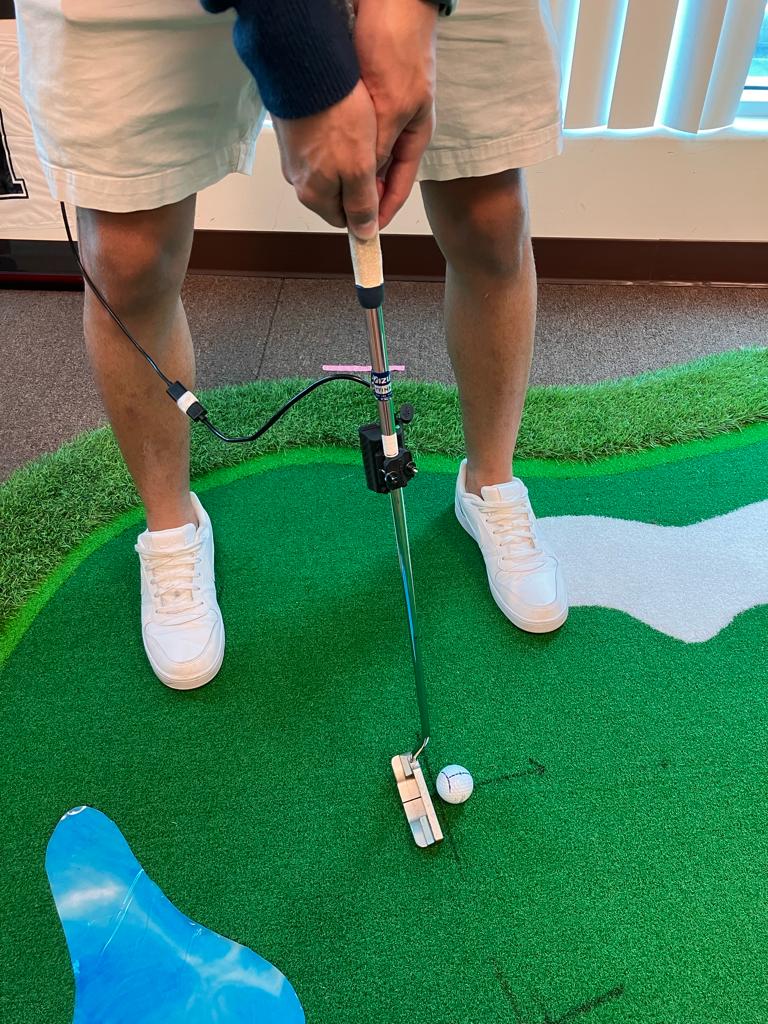
The limitations of this study should be kept in mind :
- Participants were beginner golfers trying their best (aided by the course instructor) to swing as the developers of the swing styles intended.
- There was not enough time to adequately practice each style.
RESULTS
For a beginner golfer, not just the actual outcome matters, but the consistency of the golfer’s stroke. An excellent measure of consistency (variance in statistics) is the coefficient of variation (CoV, which is standard deviation / mean). It is an indication of the spread of the results away from the mean. In the graph below, the blue curve, with all results very close to the mean/average, would have a lower CoV than the red curve where results are very spread out, i.e quite different.
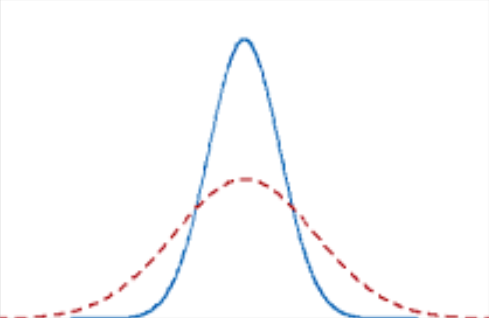
This study had one predictor variable (the four swing styles) and nine outcome variables (face, loft, path, angle of attack, kernel, energy balance, torque energy loss, handling, and speed). Thus an appropriate analysis would be a one-way Repeated Measures Multivariate Analysis of Variance (RM MANOVA). However, no analysis was made as there were too few participants (n = 8) and simply too many outcome measures. So this study was more in the nature of a pilot study.
The results are presented in the table below. A look at both the average and the CoV in the table may be useful.
[Example: TABS, SSS and PILS all have an average of less than one degree closed face at impact, but the CoV of TABS is very slightly lower (not necessarily significantly lower). ]
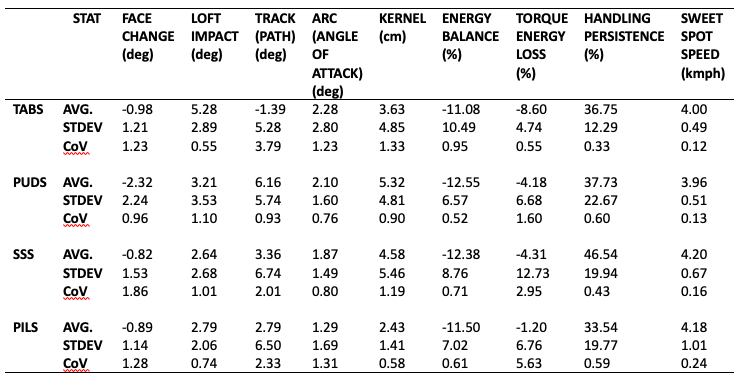
Note. Face – open is +ve, Loft – add loft is +ve, Path in-to-out is +ve, Angle of Attack upwards is +ve, Putt Kernel smaller means more straight-back-straight-through, Energy Balance combines results from Torque Energy Loss (next column), top/backspin and sidespin and less is better, Torque Energy Loss from toe hits is +ve, Handling Persistence less is better, Speed, typical putter speed is 3.22 kmph.
It is also important for a golfer to subjectively find the set-up and stroke for the putt to be both easy (to understand and perform) and comfortable (on the body). Subjective rankings were collected from participants
A Friedman’s Test (using this calculator: https://www.socscistatistics.com/tests/friedman/default.aspx) for repeated measures for an analysis of ranks was made from the following results and the p value (significance at <.05) showed no significant difference between the four groups ( p = .369).
However, a brief glance at the table below indicates which style participants were most and least comfortable making, on the whole.
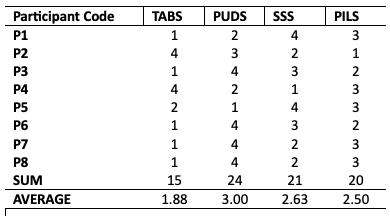
Note. Participants ranked each stroke for ease and comfort and both set-up and stroke and provided a subjective composite score, 1 being easiest and most comfortable and 4 being least.
CONCLUSION
In conclusion, research is fun and produces interesting information, Capto is a great, must-use sensor for putting, and all golfers should work more on their putting stroke!
ACKNOWLEDGMENTS
The author wishes to thank:
- Capto for the loan of the sensor
- Francesca Ceccaroni of Capto for her invaluable and immense help throughout the project
- Jochem Burghouts (JB), expert coach and maker of Capto certification courses, for advice on best outcome measures to use for this study.


